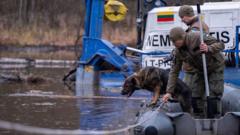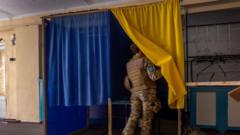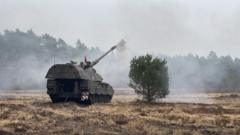In a marked increase of military vigilance, NATO has ramped up monitoring operations in the Baltic Sea, heightened by recent incidents involving suspected Russian sabotage.
NATO's Aerial Shield: Monitoring Russian Movements in the Baltic

NATO's Aerial Shield: Monitoring Russian Movements in the Baltic
A new NATO initiative utilizes maritime patrol planes to deter potential sabotage in the Baltic Sea.
The Baltic Sea is a strategic area, increasingly fraught with tension as NATO conducts maritime surveillance operations amid growing concerns of Russian aggression. The French Navy is at the forefront of this initiative with its Atlantique 2 patrol aircraft.
During a recent 14-hour mission, crew members onboard the Atlantique 2 employed advanced surveillance technology to keep watch over commercial shipping lanes and Russian naval vessels. The aircraft, designed primarily for anti-submarine warfare, was stripped of munitions for this operation, its focus solely on observation. "We are to show that we are here," declared Lieutenant Commander Romain, emphasizing the aircraft's presence over Russian warships, one of which was spotted during the patrol.
The Baltic Sea has been anything but peaceful, resembling a militarized zone due to the presence of Northern European and Russian naval forces engaged in strategic standoffs. Complicating matters, Russian forces attempted to disrupt the Atlantique 2's operations—once jamming its GPS and another time when a Russian naval ship locked radar onto the plane, indicating a potential threat.
Recent sabotage incidents involving commercial vessels damaging critical underwater communications cables and gas pipelines have heightened European apprehensions, putting the Kremlin under scrutiny as the possible instigator. Despite the absence of concrete evidence, the fact that Russian military activity is intensifying warrants ongoing surveillance efforts.
NATO’s proactive measures not only underscore the alliance's readiness to respond to potential threats but also reflect a changing dynamic in geopolitical relations across Europe. The heightened military presence and increased aerial patrols signal a commitment to regional security and deterrence against acts that undermine infrastructure critical to both military and civilian operations.
During a recent 14-hour mission, crew members onboard the Atlantique 2 employed advanced surveillance technology to keep watch over commercial shipping lanes and Russian naval vessels. The aircraft, designed primarily for anti-submarine warfare, was stripped of munitions for this operation, its focus solely on observation. "We are to show that we are here," declared Lieutenant Commander Romain, emphasizing the aircraft's presence over Russian warships, one of which was spotted during the patrol.
The Baltic Sea has been anything but peaceful, resembling a militarized zone due to the presence of Northern European and Russian naval forces engaged in strategic standoffs. Complicating matters, Russian forces attempted to disrupt the Atlantique 2's operations—once jamming its GPS and another time when a Russian naval ship locked radar onto the plane, indicating a potential threat.
Recent sabotage incidents involving commercial vessels damaging critical underwater communications cables and gas pipelines have heightened European apprehensions, putting the Kremlin under scrutiny as the possible instigator. Despite the absence of concrete evidence, the fact that Russian military activity is intensifying warrants ongoing surveillance efforts.
NATO’s proactive measures not only underscore the alliance's readiness to respond to potential threats but also reflect a changing dynamic in geopolitical relations across Europe. The heightened military presence and increased aerial patrols signal a commitment to regional security and deterrence against acts that undermine infrastructure critical to both military and civilian operations.





















